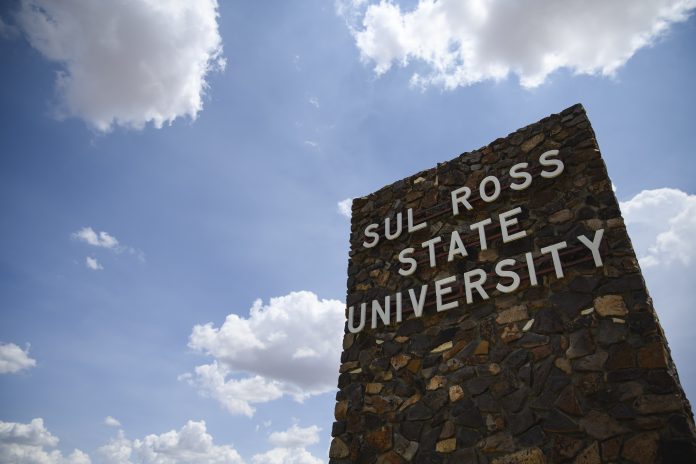Students in the Sul Ross State University McNair Scholar Program have presented at several conferences this fall.
The McNair program is designed to prepare undergraduate students for doctoral studies through involvement in research and other scholarly activities with a goal of increasing graduate degree awards for students from underrepresented segments of society.
SRSU students attended and presented at the Mathematical Association of America in Philadelphia, the Baylor University McNair Research Conference in Waco, the Heartland McNair Conference in Kansas City, the meeting of the Geological Society of America in Denver, and at the Society of Advancing Chicanos/Hispanics and Native Americans in Science in San Juan, Puerto Rico.
All of the scholars presented at the Tafoya McNair Symposium at SRSU in Alpine.
Students and their mentors, research title and a brief synopsis are outlined below.
Emily Jillson (Early) is mentored by Dr. Christopher Herrera.
Her research is titled “The Effects of Pre-Workout Supplementation on Muscular Strength, Muscular Endurance, and Self-Rated Performance in Recreationally Active Women During Menstruation.”
Synopsis: “Recent studies have tested the effects of multi-ingredient pre-workout supplements (MIPS) on different aspects of human performance. Some researchers have found supplementation of MIPS prior to exercise improves performance while others have found varying results. The use of pre-workout is becoming increasingly prevalent among active individuals. Although some benefits have been found, there appears to be a placebo effect and impacts on women are generally unknown.”
Mauricio Perez (El Paso) is mentored by Dr. Kris Jorgenson.
His research is titled “Vector Function Modeling of Free Kicks.”
Synopsis: “In this research, I will be modeling the trajectory of projectile motion from a soccer free kick scored into a goal with vector functions in three-dimensional space. There’s no wind present in soccer stadiums because they are built to avoid that part of nature. By using 3-Dimensional vector functions to model soccer kicks with the presence of wind, we can see their trajectory. We will look at free kick examples on the Earth and Mars with presence of wind. We will also look at an example on the Moon where there is no wind as a prelude to examples of soccer free kicks on Earth in soccer stadiums where there is no wind.”
Brandon Mayers (Kilgore) is mentored by Dr. Shanna Moody.
His research is titled “The Assessment of Lower Extremity Range of Motion in Collegiate Rodeo Athletes.”
Synopsis: “Collegiate rodeo athletes are a unique group of competitors. While they compete for and represent their college in competition, due to the financial nature of the sport, rodeo is not considered an NCAA sport. Therefore, these athletes do not receive training, medical attention, or other institutional support provided to traditional athletes. Additionally, there is little research or data collected on these athletes. The purpose of this study is to identify the relationship between lower extremity range of motion and posture dysfunction by obtaining baseline joint goniometric measurements, muscular imbalance, and strength in division three collegiate rodeo athletes by performing goniometry, manual muscle testing, and an overhead squat assessment.”
Tina Neufeld (Seminole) is mentored by Jesse Kelsch.
Her research is titled “Geochronologic Analysis of Multiple Occurrences of Fault-related Calcite on a Variable-Slip-Direction Fault in Big Bend National Park, Texas.”
Synopsis: “Thin section analysis supports close association of the two occurrences of calcite, lineated and non-lineated, near both the strike-slip and dip-slip slickenlines. The faultassociated, non-striated euhedral crystals are also being analyzed with U-Pb geochronology to determine whether the non-striated crystals that are coincident with slickenlines were produced coincidentally; if so, fault movement could be dated using the more abundant nonstriated crystals.”
Ronnie Rodriguez (Midland) is mentored by Jesse Kelsch.
His research is titled “Strain analysis and geochronology of a shear zone and slickenlines along a section of the Boquillas fault in Big Bend National Park, Texas.”
Synopsis: “Strain analysis of a mesoscale shear zone outcropping adjacent to the Boquillas fault was undertaken to relate this fault-proximal deformation zone with sense of motion recorded on the fault. Thin sections from among these zones were also analyzed for sense of motion. All four geologic map sections show a top-to-the-right sense of motion which most closely corresponds to the strike-slip lineation. This may suggest this fault motion is the most recent of the variable recorded directions.”
Valerie Rojo (Presidio) is mentored by Dr. Theron Francis.
Her research is titled “The Art of Nonsense Literature.”
Synopsis: Nonsense writing is a genre of children’s literature that appeals to parents, teachers and young audiences. The traits of conducive rhythm or rhyme, playful language, and comedy are in connection with the irrational, lead to a world of dreams and rely on improbable contrasts such as juxtapositions. Through the illustrations, the depiction of surrealism is observed. Its significance and enticement to adults and children can be unveiled through its functionality in homes and schools by humor, imagination, and connection. It is pure nonsense with the intention of freeing others from the rules and responsibilities of society.”
Vanessa Salazar (El Paso) is mentored by Dr. Alicia Trotman.
Her research is titled “Promoting Restorative and Integrative Mental Health/Promotores De La Salud Mental Restauradora Y Integrativa.”
Synopsis: “Coupled with the need to promote good physical health at colleges for students, staff and faculty, there is an immense need to advocate for mental health awareness and suicide prevention. Specifically, these programs should be crisis-oriented, and uniquely meet the psychological and psychosocial needs of those involved. Furthermore, these programs target context and trauma determinants shaping social and culturally informed support for students, staff and faculty. This resembles a model of ‘promotoras/es’ or lay helpers used in many fields and culturally consistent with being a Hispanic Serving Institution (HSI) (CDC, 2019). Our objective is to create a multicultural and multi-layered mental health program for our university.”




